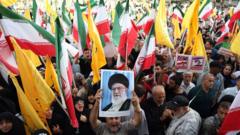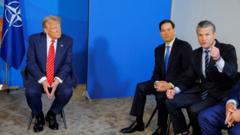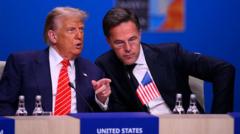NATO leaders have reached a consensus on military spending but disagreements remain, particularly involving Spain's defense contributions, reflecting ongoing tensions within the alliance.
NATO Summit Sees Compromise on Military Spending Goals

NATO Summit Sees Compromise on Military Spending Goals
Leaders agree to a 5% defense spending target but avoid concrete commitments by using ambiguous language.
In a significant development at the NATO summit held in The Hague on June 25, 2025, member states announced an aspirational commitment to achieving a defense spending target of 5 percent of their Gross Domestic Product (GDP). However, the language surrounding this commitment has been criticized for its vagueness, allowing the alliance to dodge firm obligations.
NATO Secretary General Mark Rutte claimed some success in meeting U.S. President Donald Trump's longstanding demands for increased spending, despite the fact that not every member nation is set to meet the new goal. The consensus reached was specified in the summit's final communiqué, stating that “allies” would endeavor to reach the 5 percent figure, intentionally omitting the phrase “all allies.”
Trump commended this outcome but specifically rebuked Spain for its lower defense spending, currently at approximately 1.28 percent of GDP. His comments were pointed: “Spain is terrible, what they’ve done,” as he hinted at possible repercussions for their military investment levels amid ongoing negotiations on trade matters. “We’re going to make them pay twice as much. I’m actually serious about that,” he added, underscoring the tension between U.S. expectations and European compliance.
The softened language in the communiqué emerged after negotiation efforts between Rutte and Spanish Prime Minister Pedro Sánchez aimed at preserving unity within NATO and addressing intra-alliance discrepancies, particularly within the context of the summit's tight schedule.
As leaders continue to face pressure for increased military spending by their populations and partners, the implications of these discussions and the varying levels of commitment could shape NATO's strategic posture in the years to come, with significant sociopolitical ramifications for member states balancing national security with domestic priorities.
NATO Secretary General Mark Rutte claimed some success in meeting U.S. President Donald Trump's longstanding demands for increased spending, despite the fact that not every member nation is set to meet the new goal. The consensus reached was specified in the summit's final communiqué, stating that “allies” would endeavor to reach the 5 percent figure, intentionally omitting the phrase “all allies.”
Trump commended this outcome but specifically rebuked Spain for its lower defense spending, currently at approximately 1.28 percent of GDP. His comments were pointed: “Spain is terrible, what they’ve done,” as he hinted at possible repercussions for their military investment levels amid ongoing negotiations on trade matters. “We’re going to make them pay twice as much. I’m actually serious about that,” he added, underscoring the tension between U.S. expectations and European compliance.
The softened language in the communiqué emerged after negotiation efforts between Rutte and Spanish Prime Minister Pedro Sánchez aimed at preserving unity within NATO and addressing intra-alliance discrepancies, particularly within the context of the summit's tight schedule.
As leaders continue to face pressure for increased military spending by their populations and partners, the implications of these discussions and the varying levels of commitment could shape NATO's strategic posture in the years to come, with significant sociopolitical ramifications for member states balancing national security with domestic priorities.























